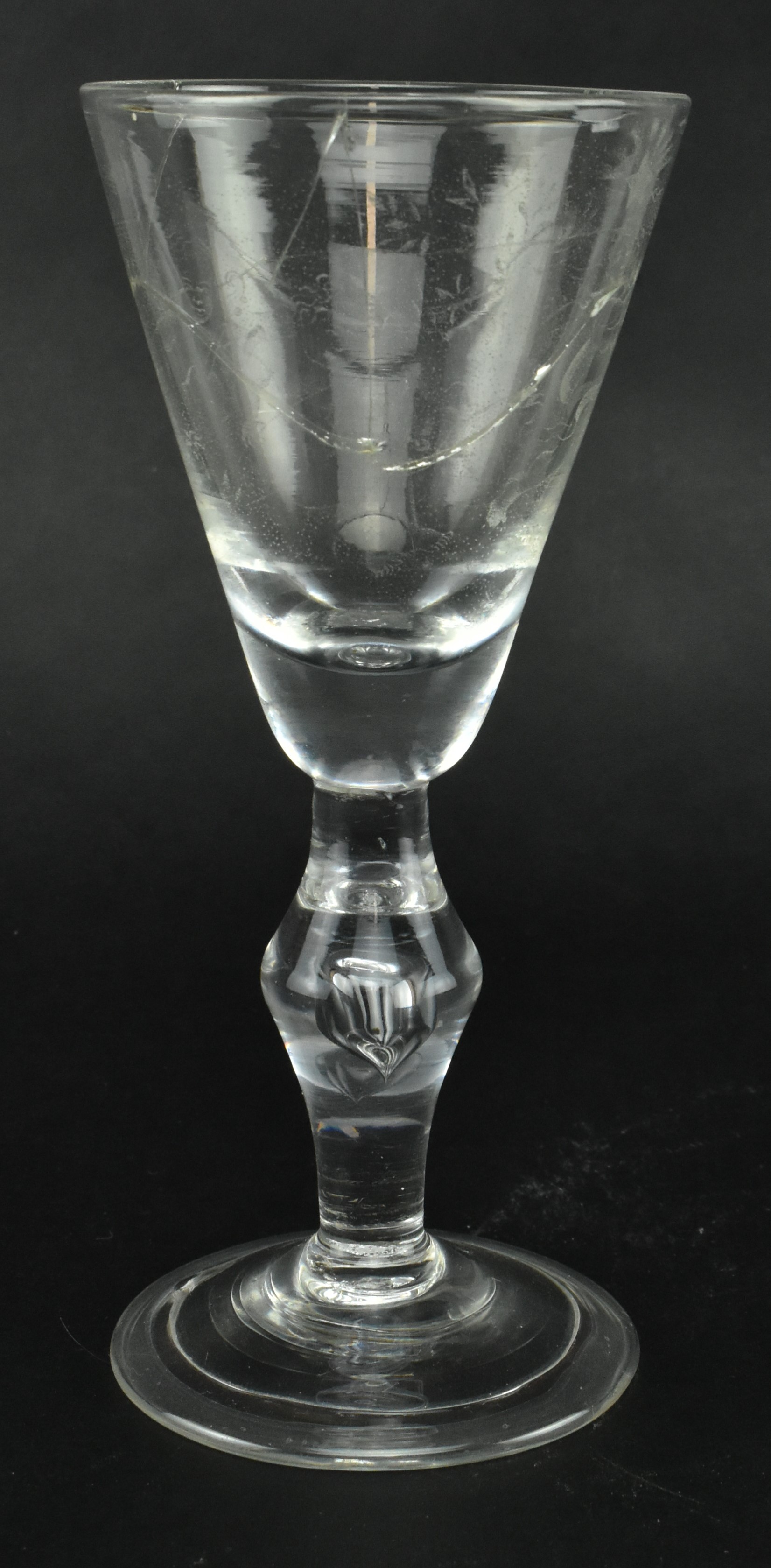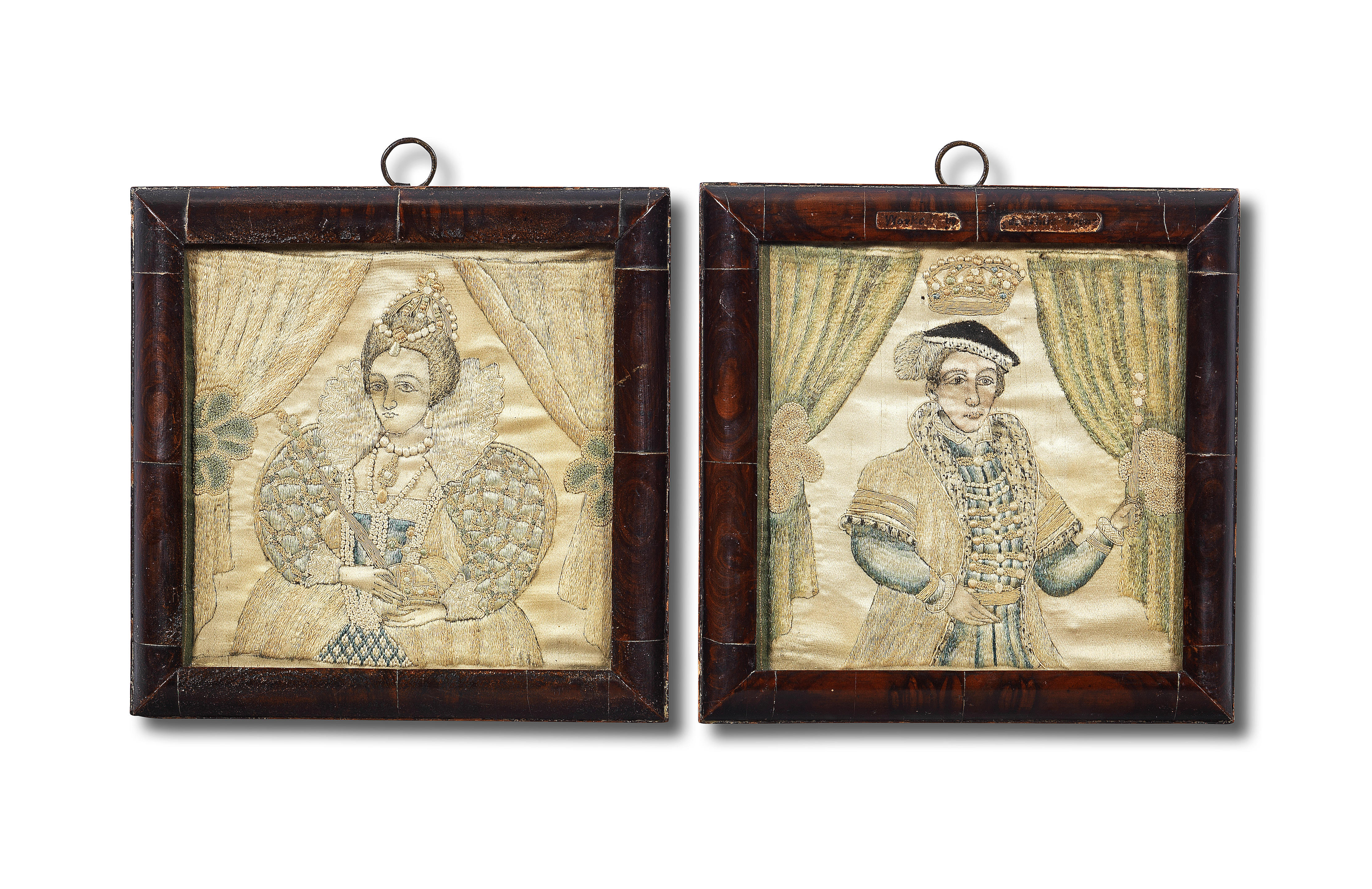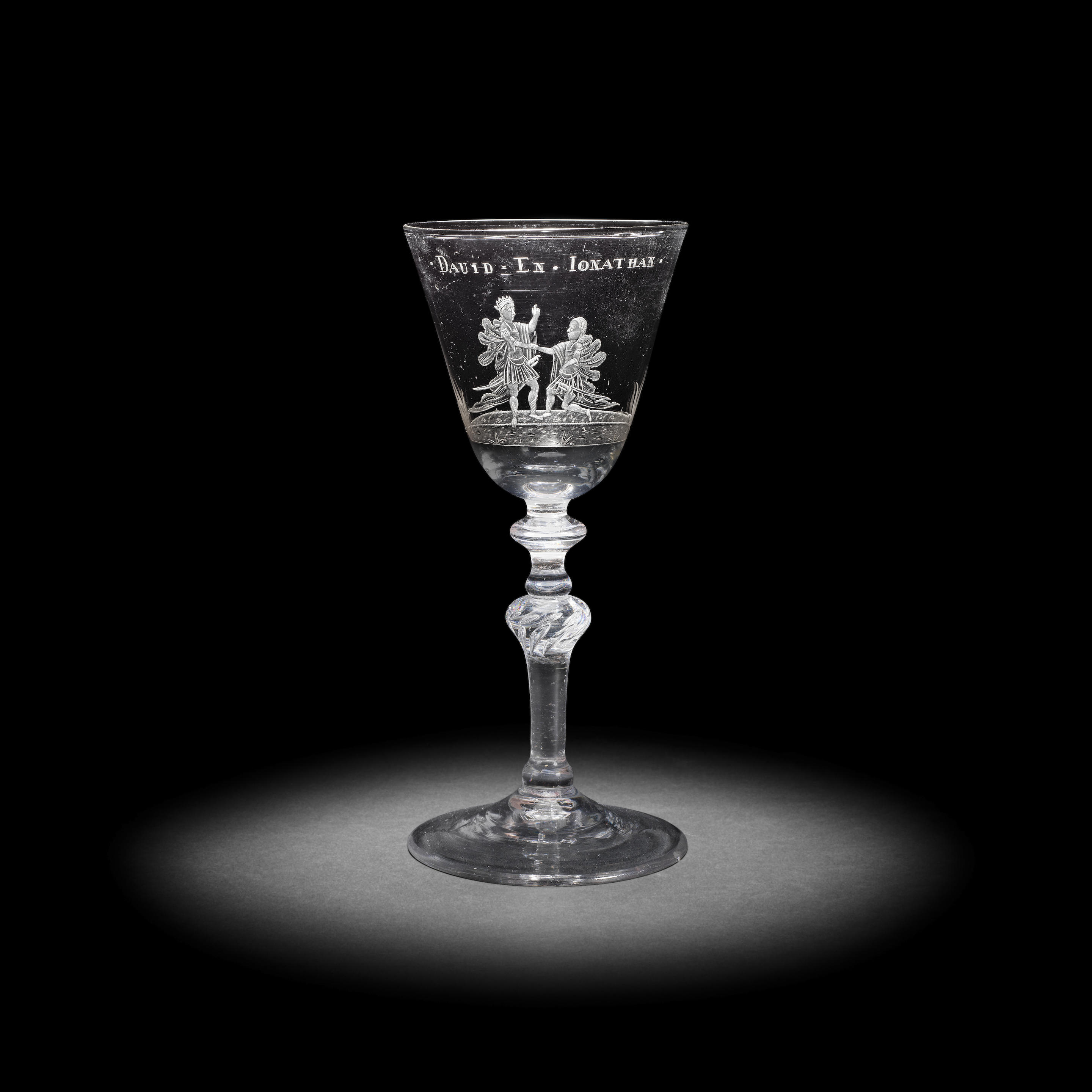An exceptionally rare Dutch engraved armorial moulded-stem 'Friendship' goblet, circa 1720-30The engraving perhaps circa 1750, the generous round funnel bowl decorated to one side with the coat of arms of van Campen, two wings beneath a crowned helmet, crested by three leafy stemmed thistles, the motto 'IN VELAMENTO ALARUM EXULTABO' (I will exult under the cover of your wings) inscribed in diamond-point on a banner beneath, all within an elaborate foliate scrollwork cartouche, the reverse with the biblical kings David and Jonathan in embrace and kissing, Jonathan wearing armour and wielding a bow, David wearing a crown and holding a harp, beneath the Latin inscription 'VITRUM AMICITIÆ' (Glass of Friendship) in diamond-point, on a most unusual spirally twisted four-sided pedestal stem containing a central tear, over a wide conical folded foot, 19.7cm highFootnotesProvenance With Frides Laméris, 15 April 2013 Stephen Pohlmann Collection The arms on the present goblet are for the van Campen family of Holland, who became Nobility of the Holy Roman Empire on 29 October 1725. The motto is a variation of Psalm 62:8, a Psalm of David when he was in the wilderness of Judah, making the scene on the other side even more pertinent. For the story of David and Jonathan, see the footnote to lot 21 in this sale. Whilst depictions of David and Jonathan on 18th century glass typically emphasise the platonic interpretation of their relationship, the figures in the highly unusual kissing pose on the present glass may suggest a homosexual interpretation. The engraving on the present goblet relates to a small but distinct group of English heavy baluster glasses with wheel-engraved decoration and diamond-point inscriptions in Latin. One such goblet depicting David and Jonathan, also with the inscription 'AMICITAE' in diamond-point and the only recorded example of the subject on a heavy baluster glass, is illustrated by Dwight Lanmon, The Golden Age of English Glass (2011), pp.140-1, no.41 and was sold by Bonhams on 20 May 2015, lot 31. A 'Liberty' goblet from the same group was sold by Bonhams on 29 September 2020, lot 42. Lanmon states that the quality of the engraving suggests the work of someone trained in the Netherlands, and whilst most Dutch engraved glasses have wheel-engraved inscriptions, the Dutch armorial here would appear to confirm a Dutch hand. The way in which the four-sided moulded stem of this glass has been twisted during manufacture is highly unusual, with only a small handful of related glasses recorded. An example with a domed foot is in the Durrington Collection, illustrated in Roger Dodsworth's catalogue (2006), p.12, no.13. Martin Mortimer in his paper therein, 'Early Glass and Balusters', p.13, states that this rare stem formation is practically never seen. Another example, with a thistle-shaped bowl, was sold by Sotheby's on 12 November 1984, lot 5. See also the Dutch engraved glass with a related spirally twisted stem but of inverted baluster form, sold by Bonhams on 17 December 2008, lot 437.
An exceptionally rare Dutch engraved armorial moulded-stem 'Friendship' goblet, circa 1720-30The engraving perhaps circa 1750, the generous round funnel bowl decorated to one side with the coat of arms of van Campen, two wings beneath a crowned helmet, crested by three leafy stemmed thistles, the motto 'IN VELAMENTO ALARUM EXULTABO' (I will exult under the cover of your wings) inscribed in diamond-point on a banner beneath, all within an elaborate foliate scrollwork cartouche, the reverse with the biblical kings David and Jonathan in embrace and kissing, Jonathan wearing armour and wielding a bow, David wearing a crown and holding a harp, beneath the Latin inscription 'VITRUM AMICITIÆ' (Glass of Friendship) in diamond-point, on a most unusual spirally twisted four-sided pedestal stem containing a central tear, over a wide conical folded foot, 19.7cm highFootnotesProvenance With Frides Laméris, 15 April 2013 Stephen Pohlmann Collection The arms on the present goblet are for the van Campen family of Holland, who became Nobility of the Holy Roman Empire on 29 October 1725. The motto is a variation of Psalm 62:8, a Psalm of David when he was in the wilderness of Judah, making the scene on the other side even more pertinent. For the story of David and Jonathan, see the footnote to lot 21 in this sale. Whilst depictions of David and Jonathan on 18th century glass typically emphasise the platonic interpretation of their relationship, the figures in the highly unusual kissing pose on the present glass may suggest a homosexual interpretation. The engraving on the present goblet relates to a small but distinct group of English heavy baluster glasses with wheel-engraved decoration and diamond-point inscriptions in Latin. One such goblet depicting David and Jonathan, also with the inscription 'AMICITAE' in diamond-point and the only recorded example of the subject on a heavy baluster glass, is illustrated by Dwight Lanmon, The Golden Age of English Glass (2011), pp.140-1, no.41 and was sold by Bonhams on 20 May 2015, lot 31. A 'Liberty' goblet from the same group was sold by Bonhams on 29 September 2020, lot 42. Lanmon states that the quality of the engraving suggests the work of someone trained in the Netherlands, and whilst most Dutch engraved glasses have wheel-engraved inscriptions, the Dutch armorial here would appear to confirm a Dutch hand. The way in which the four-sided moulded stem of this glass has been twisted during manufacture is highly unusual, with only a small handful of related glasses recorded. An example with a domed foot is in the Durrington Collection, illustrated in Roger Dodsworth's catalogue (2006), p.12, no.13. Martin Mortimer in his paper therein, 'Early Glass and Balusters', p.13, states that this rare stem formation is practically never seen. Another example, with a thistle-shaped bowl, was sold by Sotheby's on 12 November 1984, lot 5. See also the Dutch engraved glass with a related spirally twisted stem but of inverted baluster form, sold by Bonhams on 17 December 2008, lot 437.






.jpg?w=400)







/49030/Internet%20Image%201.jpg)
Try LotSearch and its premium features for 7 days - without any costs!
Be notified automatically about new items in upcoming auctions.
Create an alert